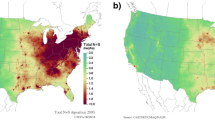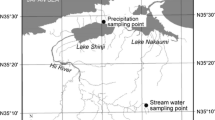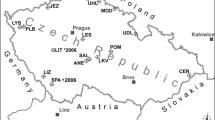Abstract
The relative contribution of HN03 to precipitation acidity in eastern Canada has increased in recent years leading to some concern that the relative importance of NO− 3 deposition in acidification of terrestrial and aquatic ecosystems may increase. To gauge the extent of this impact, annual mass balances for N0− 3 and NH+ 4 were calculated for several forested catchments and lakes in Ontario. Retention of NH+ 4 (R NH4) by forested catchments was consistently high compared to retention of NO3 − (R NO3) which was highly variable. Retention of inorganic nitrogen was influenced by catchment grade and areal water discharge. In lakes, the reciprocals of retention of N0− 3 and NH+ 4 were linearly related to the ratio of lake mean depth to water residence time (z/τ; equal to areal water discharge), and retention did not appear to be a function of degree of acidification of the lakes. Net N consumption-based acidification of lakes, defined as the ratio of annual NH; mass to N0− 3 mass consumption, was negatively correlated with /τ and N consumption-related acidification was most likely to occur when − was < 1.5 m yr−1.
If retention mechanisms are unaffected by changes in deposition, changes in deposition will still result in changes in surface water concentrations although the changes will be of similar proportions. Therefore, ‘NO− 3 saturation’ should not be defined by concentrations alone, but should be defined as decreasing long-term, average NO− 3 retention in streams and lakes in response to long-term increases in NO− 3 deposition. Analysis o f survey data will be facilitated by grouping lakes and catchments according to similar characteristics.
Similar content being viewed by others
References
Aber JD, Nadelhoffer KJ, Steudler P & Melillo JM (1989) Nitrogen saturation in northern forest ecosystems. Bio Science 39: 378–386
Barrie LA & Hales JM (1984) The spatial distributions of precipitation acidity and major ion wet deposition in North America during 1980. Tellus 36: 333–335
Brewer PG & Goldman JC (1976) Alkalinity changes generated by phytoplankton growth. Limnology and Oceanography 21: 108–117
Coote DR, MacDonald EM, Dickinson WT, Ostry RC & Frank R (1982) Agricultural and water quality in the Canadian Great Lakes Basin: 1. Representative agricultural watersheds. Journal of Environmental Quality 11: 473–481
Dillon PJ, Reid RA & de Grosbois E (1987) The rate of acidification of aquatic ecosystems in Ontario, Canada. Nature 329: 45–48
Dillon PJ, Lusis M, Reid R & Yap D (1988) Ten-year trends in sulphate, nitrate and hydrogen deposition in central Ontario. Atmospheric Environment 22: 901–905
Galloway JN & Dillon PJ (1983) Effects of acid deposition: the importance of nitrogen. In: Ecological Effects of Acid Deposition (pp 145–160). National Swedish Environment Protection Board — Report PM 1636
Galloway JN, Schofield CL, Hendrey GR, Altwicker ER & Troutman DE (1980) An analysis of lake acidification using annual budgets. In: Drablos D & Tollan A (Eds) Ecological Impact of Acid Precipitation (pp 254–255). Proceedings, International Conference, SNSF Project, Oslo, Norway, 383 p
Girard R, Reid RA & Snyder WR (1985) The morphometry and geology of Plastic and Heney Lakes and their catchments. Ontario Ministry of the Environment, Data Report DR 85/1, Dorset, Ontario, Canada, 29 p
Grennfelt P & Hultberg H (1986) Effects of nitrogen deposition on the acidification of terrestrial and aquatic ecosystems. Water, Air, and Soil Pollution 30: 945–963
Hemond HE & Eshleman KN (1984) Neutralization of acid deposition by nitrate retention at Bickford Watershed, Massachusetts. Water Resources Research 20: 1718–1724
Henriksen A & Brakke DF (1988) Increasing contributions of nitrogen to the acidity of surface waters in Norway. Water, Air, and Soil Pollution 42: 183–201
Henriksen A & Wright RF (1977) Effects of acid deposition on a small acid lake in southern Norway. Nordic Hydrology 8: 1–10
Jeffries DS, Scheider WA & Snyder WR (1984) Geochemical interactions of watersheds with precipitation in areas affected by smelter emissions near Sudbury, Ontario. In: Nriagu J (Ed)Environmental Impacts of Smelters (pp 195–241). John Wiley and Sons, Toronto
Jeffries DS & Semkin RG (1982) Basin description and information pertinent to mass balance studies of the Turkey Lakes Watershed. Turkey Lakes Watershed Unpublished Report No. TLW-82-01, Canada Centre for Inland Waters, Burlington, Ontario, Canada, 9 p
Jeffries DS & Semkin RG (1983) Changes in snowpack, stream, and lake chemistry during snowmelt in the Turkey Lakes Watershed. Turkey Lakes Watershed Unpublished Report No. TLW-83-10, Canada Centre for Inland Waters, Burlington, Ontario, Canada, 34 p
Jeffries DS & Snyder WR (1983) Geology and geochemistry of the Muskoka-Haliburton study area. Ontario Ministry of the Environment, Data Report DR 83/2, Dorset, Ontario, Canada, 101 p
Keeney DR, Chen RL & Graetz DA (1971) Importance of denitrification and nitrate reduction in sediments to the nitrogen budgets of lakes. Nature 233: 66–67
Kelly CA, Rudd JWM, Hesslein RH, Schindler DW, Dillon PJ, Driscoll CT, Gherini SA & Hecky RE (1987) Prediction of biological acid neutralization in acid-sensitive lakes. Biogeochemistry 3: 129–140
Kelly CA, Rudd JWM & Schindler DW (1990) Acidification by nitric acid — future considerations. Water, Air, and Soil Pollution (in press)
Kenney BC (1982) Beware of spurious self-correlations. Water Resources Research 18: 1041–1048
Kerekes J, Howell G, Beauchamp S & Pollock T (1982) Characterization of three lake basins sensitive to acid precipitation in central Nova Scotia (June, 1979 to May, 1980). Internationale Revue der gesamten Hydrobiologie 67: 679–694
Klein TM, Kreitinger JP & Alexander M (1983) Nitrate formation in acid forest soils from the Adirondacks. Soil Science Society of America Journal 47: 506–508
Knowles R (1982) Denitrification. Microbiological Reviews 46: 43–70
Knowles R & Lean DRS (1987) Nitrification: a significant cause of oxygen depletion under winter ice. Canadian Journal of Fisheries and Aquatic Sciences 44: 743–749
Kowalenko CG (1979) The influence of sulfur anions on denitrification. Canadian Journal of Soil Science 59: 221–223
Lang E & Jagnow G (1986) Fungi of a forest soil nitrifying at low pH values. FEMS Microbiology Ecology 38: 257–268
LaZerte BD & Dillon PJ (1984) Relative importance of anthropogenic versus natural sources of acidity in lakes and streams in central Canada. Canadian Journal of Fisheries and Aquatic Sciences 41: 1664–1677
Likens GE, Bormann FH, Pierce RS, Eaton JS & Johnson NM (1977) Biogeochemistry of a Forested Ecosystem. Springer-Verlag, NY, 146 p
Linsey GA, Schindler DW & Stainton MP (1987) Atmospheric deposition of nutrients and major ions at the Experimental Lakes Area in northwestern Ontario, 1970–1982. Canadian Journal of Fisheries and Aquatic Sciences 44 (Supplement 1): 206–214
Locke BA & Scott LD (1986) Studies of lakes and watersheds in Muskoka-Haliburton, Ontario: Methodology (1976–1985). Ontario Ministry of the Environment, Data Report DR 86/4, Dorset, Ontario, Canada, 80 p
McLean RAN (1981) The relative contributions of sulfuric and nitric acids in acid rain to the acidification of the ecosystem. Implications for control strategies. Journal of the Air Pollution Control Association 31: 1184–1187
Molot LA, Dillon PJ & Booth GM (1990) Whole-lake and nearshore water chemistry in Bowland Lake before and after treatment with CaC03. Canadian Journal of Fisheries and Aquatic Sciences, 47: 412–421
Ontario Ministry of the Environment (1983) Handbook of Analytical Methods for Environmental Samples, Vol 1. Laboratory Services Branch
Newbury RW & Beaty KG (1980) Water renewal efficiency of watershed and lake combinations in the ELA region of the Precambrian Shield. Canadian Journal of Fisheries and Aquatic Sciences 37: 335–341
Papineau M (1987) Effects of acid precipitation on a boreal forest ecosystem: ion budgets and changes in water chemistry for the Laflamme Lake watershed, Quebec. Environment Canada, Inland Waters Directorate, Quebec Region, 110 p
Rudd JWM, Kelly CA, St. Louis V, Hesslein RH, Furutani A & Holoka MH (1986) Microbial consumption of nitric and sulfuric acids in acidified north temperate lakes. Limnology and Oceanography 31: 1267–1280
Rudd JWM, Kelly CA, Schindler DW & Turner MA (1988) Disruption of the nitrogen cycle in acidified lakes. Science 240: 1515–1517
Scheider WA (1984) Lake water budgets in areas affected by smelting practices near Sudbury, Ontario. In: Nriagu J (Ed) Environmental Impacts of Smelters (pp 155–194). John Wiley andSons, Toronto
Scheider WA, Cox CM & Scott LD (1983) Hydrological data for lakes and watersheds in the Muskoka-Haliburton Study Area (1976–1980). Ontario Ministry of the Environment Data Report, DR 83/6, Dorset, Ontario, Canada
Schindler DW, Newbury RW, Beaty KG & Campbell P (1976) Natural water and chemical budgets for a small Precambrian lake basin in central Canada. Canadian Journal of the Fisheries Research Board 33: 2526–2543
Schindler DW, Newbury RW, Beaty KG, Prokopowich J, Ruszczynski T & Dalton JA (1980a) Effects of a windstorm and forest fire on chemical losses from forested watersheds and on the quality of receiving streams. Canadian Journal of Fisheries and Aquatic Sciences 37: 328–334
Schindler DW, Turner MA & Hesslein RH (1985) Acidification and alkalization of lakes by experimental addition of nitrogen compounds. Biogeochemistry 1: 117–133
Schindler DW, Turner MA, Stainton MP & Linsey GA (1986) Natural sources of acid neutralizing capacity of low alkalinity lakes of the Precambrian Shield. Science 232: 844–847
Schindler DW, Wageman R, Cook RB, Ruszczynski T & Prokopowich J (1980b) Experimental acidification of Lake 223, Experimental Lakes Area: Background data and the first three years of acidification. Canadian Journal of Fisheries and Aquatic Sciences 37: 342–354
Seip HM, Seip R, Dillon PJ & de Grosbois E (1985) Model of sulphate concentration in a small stream in the Harp Lake catchment, Ontario. Canadian Journal of Fisheries and Aquatic Sciences 42: 927–937
Semkin RG & Jeffries DS (1983) Rock chemistry in the Turkey Lakes Watershed. Turkey Lakes Watershed Unpublished Report No. TLW-83-03, Canada Centre for Inland Waters, Burlington, Ontario, Canada, 9 p
Strayer RF, Lin C-J & Alexander M (1981) Effect of simulated acid rain on nitrification and nitrogen mineralization in forest soils. Journal of Environmental Quality 10: 547–551
Syrett PJ (1981) Nitrogen metabolism of microalgae. In: Platt T (Ed) Physiological Bases of Phytoplankton Ecology (pp 182–210). Canadian Bulletin of Fisheries and Aquatic Sciences 210, 346 p
Szperlinski Z & Badowska K (1977a) Significance of sorption properties of soils in predicting the migration of nitrogen compounds into natural waters. Ekologia Polska 25: 675–688
Szperlinski Z (1977b) & Badowska K The effect of intense fertilization on migration of nitrogen compounds in soil. Ekologia Polska 25: 689–702
van Breemen N, Burrough PA, Velthorst EJ, van Dobben HF, de Wit T, Ridder TB & Reigners HFR (1982) Soil acidification from atmospheric ammonium sulphate in forest canopy throughfall. Nature 299: 548–550
Vollenweider RA (1969) Moglichkeiten and Grenzen elementarer Modelle der Stoffbilanz von Seen. Archive fur Hydrobiologie 66: 1–36
Wright RF (1983) Input-output budgets at Langtjern, a small acidified lake in southern Norway. Hydrobiologia 101: 1–12
Wright RF & Johannessen M (1980) Input-output budgets of major ions at gauged catchments in Norway. In: Drablos D & Tollan A (Eds) Ecological Impact of Acid Precipitation (pp 250–251). Proceedings, International Conference, SNSF Project, Oslo, Norway, 383 p
Yan ND & Dillon PJ (1984) Experimental neutralization of lakes near Sudbury, Ontario. In: Nriagu J (Ed) Environmental Impacts of Smelters (pp 418–456). John Wiley and Sons, Toronto
Zeman LJ (1975) Hydrochemical balance of a British Columbia mountainous watershed. Catena 2: 81–94
Author information
Authors and Affiliations
Rights and permissions
About this article
Cite this article
Dillon, P.J., Molot, L.A. The role of ammonium and nitrate retention in the acidification of lakes and forested catchments. Biogeochemistry 11, 23–43 (1990). https://doi.org/10.1007/BF00000850
Accepted:
Issue Date:
DOI: https://doi.org/10.1007/BF00000850




